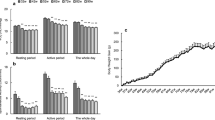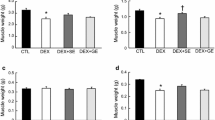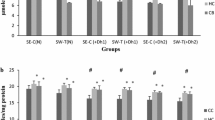Abstract
Reduced bone mineral density, and muscle strength are the hallmark of aging-related motor coordination deficits and related neuropathologies. Since cerebellum regulates motor movements and balance perception of our body, therefore it may be an important target to control the age-related progression of motor dysfunctions. Dry stem powder of Tinospora cordifolia (TCP) was tested as a food supplement to elucidate its activity to attenuate age-associated locomotor dysfunctions. Intact acyclic middle-aged female rats were used in this study as the model system of the transition phase from premenopause to menopause in women along with cycling young adult rats. Normal chow or 30% High Fat Diet (HFD), supplemented with or without TCP was fed to animals for 12 weeks and then tested for locomotor performance on rotarod followed by post-sacrifice protein expression studies. In comparison to young adults, middle-aged animals showed an increase in number of falls and lesser time spent in rotarod performance test, whereas, animals given TCP supplemented feed showed improvement in performance with more pronounced effects observed in normal chow than HFD fed middle-aged rats. Further, due to its multicomponent nature TCP was found to target the expression of various markers of neuroinflammation, apoptosis, cell survival, and synaptic plasticity in the cerebellum region. The current findings suggest that TCP supplementation in the diet may prove to be a potential interventional strategy for the management of frailty and fall-associated morbidities caused by aging-related deterioration of bone mineral density, and muscle strength.
Graphical abstract







Similar content being viewed by others
Data availability
All data generated or analysed during this study are included in this article.
Abbreviations
- Akt:
-
Protein kinase B
- AP-1:
-
Activator protein 1
- BAD:
-
BCL2 associated agonist of cell death
- Bax:
-
Bcl-2-associated X protein
- Bcl-xL:
-
B-cell Lymphoma-extra large
- BDNF:
-
Brain-derived neurotrophic factor
- B-TCE:
-
Butanol extract of Tinospora cordifolia
- CNS:
-
Central nervous system
- CREB:
-
CAMP-response element binding protein
- ERα/β:
-
Estrogen receptor α/β
- ERK:
-
Extracellular signal-regulated kinase
- GFAP:
-
Glial fibrillary acidic protein
- HFD:
-
High fat diet
- HFD-M:
-
HFD fed middle-aged rats
- HRP:
-
Horseradish peroxidase
- HRT:
-
Hormone replacement therapy
- THFD-M:
-
TCP supplemented high-fat diet fed middle-aged rats
- IBA1:
-
Ionized calcium binding adaptor molecule 1
- IL-1β:
-
Interleukin 1 beta
- IL-6:
-
Interleukin 6
- LFD-M:
-
Low fat diet fed middle-aged rats
- TLFD-M:
-
TCP supplemented low fat diet fed middle-aged rats
- LFD-Y:
-
Low fat diet fed young control rats
- MAPK:
-
Mitogen-activated protein kinase
- MCP-1:
-
Monocyte chemoattractant protein-1
- MPTP:
-
1-Methyl-4-phenyl-1,2,3,6-tetrahydropyridine
- nNOS:
-
Neuronal nitric oxide synthase
- OVX:
-
Ovariectomized
- PFC:
-
Prefrontal cortex
- SEM:
-
Standard error of mean
- SERM:
-
Selective estrogen receptor modulator
- SKA:
-
Sequentially kinetic activated
- TBST:
-
Tris buffered saline with tween
- TCE:
-
Hydroalcoholic extract of Tinospora cordifolia
- TCP:
-
Dry stem powder of Tinospora cordifolia
- TNF-α:
-
Tumour necrosis factor alpha
- Trkβ:
-
Tropomyosin receptor kinase B
References
Abiramasundari G, Mohan Gowda CM, Sreepriya M (2018) Selective estrogen receptor modulator and prostimulatory effects of phytoestrogen β-ecdysone in Tinospora cordifolia on osteoblast cells. J Ayurveda Integr Med 9(3):161–168. https://doi.org/10.1016/j.jaim.2017.04.003
Bajaj P, Singh H, Kalotra S, Kaur G (2021) Butanol extract of Tinospora cordifolia alleviates acute sleep deprivation-induced impairments in cognitive functions and neuromuscular coordination in middle-aged female rats. Neuromol Med. https://doi.org/10.1007/s12017-021-08683-x
Bhandari A, Sharma AK, Singh H, Singh A, Kaur G (2022) Aging-related changes in metabolic indicators in female rats and their management with Tinospora cordifolia. Biogerontology. https://doi.org/10.1007/s10522-022-09962-1
Birla H, Rai SN, Singh SS, Zahra W, Rawat A, Tiwari N, Singh RK, Pathak A, Singh SP (2019) Tinosporacordifolia suppresses neuroinflammation in Parkinsonian mouse model. Neuromol Med 21(1):42–53. https://doi.org/10.1007/s12017-018-08521-7
Contreras CM, Rodríguez-Landa JF, García-Ríos RI, Cueto-Escobedo J, Guillen-Ruiz G, Bernal-Morales B (2014) Myristic acid produces anxiolytic-like effects in Wistar rats in the elevated plus maze. Biomed Res Int 2014:492141. https://doi.org/10.1155/2014/492141
de Chaves G, Moretti M, Castro AA, Dagostin W, da Silva GG, Boeck CR, Quevedo J, Gavioli EC (2009) Effects of long-term ovariectomy on anxiety and behavioral despair in rats. Physiol Behav 97(3–4):420–425. https://doi.org/10.1016/j.physbeh.2009.03.016
Dornellas AP, Watanabe RL, Pimentel GD, Boldarine VT, Nascimento CM, Oyama LM, Ghebremeskel K, Wang Y, Bueno AA, Ribeiro EB (2015) Deleterious effects of lard-enriched diet on tissues fatty acids composition and hypothalamic insulin actions. Prostaglandins Leukot Essent Fatty Acids 102–103:21–29. https://doi.org/10.1016/j.plefa.2015.10.003
Dornellas AP, Boldarine VT, Pedroso AP, Carvalho LO, De Andrade IS, Vulcani-Freitas TM, Ribeiro EB (2018) High-fat feeding improves anxiety-type behavior induced by ovariectomy in rats. Front Neurosci 12:557
Elliott KL, Kersigo J, Lee JH, Yamoah EN, Fritzsch B (2021) Sustained loss of Bdnf affects peripheral but not central vestibular targets. Front Neurol 12:768456. https://doi.org/10.3389/fneur.2021.768456
El-Tahawy NFG, Abdel Hafez SMN, Ramzy MM, Zenhom NM, Abdel-Hamid HA (2019) Effect of experimentally induced hypertension on cerebellum of postmenopausal rat. J Cell Physiol 234(8):12941–12955. https://doi.org/10.1002/jcp.27961
Finger BC, Dinan TG, Cryan JF (2011) High-fat diet selectively protects against the effects of chronic social stress in the mouse. Neuroscience 192:351–360. https://doi.org/10.1016/j.neuroscience.2011.06.072
Gennari L, Merlotti D, Valleggi F, Martini G, Nuti R (2007) Selective estrogen receptor modulators for postmenopausal osteoporosis: current state of development. Drugs Aging 24(5):361–379. https://doi.org/10.2165/00002512-200724050-00002
Jayaganthan P, Perumal P, Balamurugan TC, Verma RP, Singh LP, Pattanaik AK, Kataria M (2013) Effects of Tinospora cordifolia supplementation on semen quality and hormonal profile in rams. Anim Reprod Sci 140(1–2):47–53. https://doi.org/10.1016/j.anireprosci.2013.05.003
Kapur P, Jarry H, Wuttke W, Pereira BM, Seidlova-Wuttke D (2008) Evaluation of the antiosteoporotic potential of Tinospora cordifolia in female rats. Maturitas 59(4):329–338. https://doi.org/10.1016/j.maturitas.2008.03.006
Kapur P, Wuttke W, Jarry H, Seidlova-Wuttke D (2010) Beneficial effects of beta-Ecdysone on the joint, epiphyseal cartilage tissue and trabecular bone in ovariectomized rats. Phytomedicine 17(5):350–355. https://doi.org/10.1016/j.phymed.2010.01.005
Kargozar R, Azizi H, Salari R (2017) A review of effective herbal medicines in controlling menopausal symptoms. Electron Phys 9(11):5826–5833. https://doi.org/10.19082/5826
Khadilkar SS (2019) Musculoskeletal disorders and menopause. J Obstet Gynaecol India 69(2):99–103. https://doi.org/10.1007/s13224-019-01213-7
Komm BS, Mirkin S (2014) An overview of current and emerging SERMs. J Steroid Biochem Mol Biol 143:207–222. https://doi.org/10.1016/j.jsbmb.2014.03.003
Liu B, Hong JS (2003) Role of microglia in inflammation-mediated neurodegenerative diseases: mechanisms and strategies for therapeutic intervention. J Pharmacol ExpTher 304(1):1–7. https://doi.org/10.1124/jpet.102.035048
Markowska AL, Savonenko AV (2002) Effectiveness of estrogen replacement in restoration of cognitive function after long-term estrogen withdrawal in aging rats. J Neurosci 22(24):10985–10995. https://doi.org/10.1523/JNEUROSCI.22-24-10985.2002
Mas-Bargues C, Borrás C, Viña J (2021) Bcl-xL as a modulator of senescence and aging. Int J Mol Sci 22(4):1527. https://doi.org/10.3390/ijms22041527
Mishra R, Kaur G (2013) Aqueous ethanolic extract of Tinospora cordifolia as a potential candidate for differentiation based therapy of glioblastomas. PLoS ONE 8(10):e78764. https://doi.org/10.1371/journal.pone.0078764
Mishra R, Kaur G (2015) Tinospora cordifolia induces differentiation and senescence pathways in neuroblastoma cells. Mol Neurobiol 52(1):719–733. https://doi.org/10.1007/s12035-014-8892-5
Mishra R, Manchanda S, Gupta M, Kaur T, Saini V, Sharma A, Kaur G (2016) Tinosporacordifolia ameliorates anxiety-like behavior and improves cognitive functions in acute sleep deprived rats. Sci Rep 6:25564. https://doi.org/10.1038/srep25564
Molinari C, Morsanuto V, Ruga S, Notte F, Farghali M, Galla R, Uberti F (2020) The role of BDNF on aging-modulation markers. Brain Sci 10(5):285. https://doi.org/10.3390/brainsci10050285
Oike H, Ogawa Y, Azami K (2020) Long-term feeding of a high-fat diet ameliorated age-related phenotypes in SAMP8 mice. Nutrients 12(5):1416. https://doi.org/10.3390/nu12051416
Pecoraro N, Reyes F, Gomez F, Bhargava A, Dallman MF (2004) Chronic stress promotes palatable feeding, which reduces signs of stress: feedforward and feedback effects of chronic stress. Endocrinology 145:3754–3762
Rauf S, Soejono SK, Partadiredja G (2015) Effects of treadmill exercise training on cerebellar estrogen and estrogen receptors, serum estrogen, and motor coordination performance of ovariectomized rats. Iran J Basic Med Sci 18(6):587–592
Rauf S, Soesatyo MH, Agustiningsih D, Partadiredja G (2020) Moderate intensity intermittent exercise upregulates neurotrophic and neuroprotective genes expression and inhibits Purkinje cell loss in the cerebellum of ovariectomized rats. Behav Brain Res 382:112481. https://doi.org/10.1016/j.bbr.2020.112481
Roberts MN, Wallace MA, Tomilov AA, Zhou Z, Marcotte GR, Tran D, Perez G, Gutierrez-Casado E, Koike S, Knotts TA, Imai DM, Griffey SM, Kim K, Hagopian K, McMackin MZ, Haj FG, Baar K, Cortopassi GA, Ramsey JJ, Lopez-Dominguez JA (2017) A ketogenic diet extends longevity and healthspan in adult mice. Cell Metab 26(3):539-546.e5. https://doi.org/10.1016/j.cmet.2017.08.005
Schatz M, Saravanan S, d’Adesky ND, Bramlett H, Perez-Pinzon MA, Raval AP (2020) Osteocalcin, ovarian senescence, and brain health. Front Neuroendocrinol 59:100861. https://doi.org/10.1016/j.yfrne.2020.100861
Seidlova-Wuttke D, Christel D, Kapur P, Nguyen BT, Jarry H, Wuttke W (2010) Beta-ecdysone has bone protective but no estrogenic effects in ovariectomized rats. Phytomedicine 17(11):884–889. https://doi.org/10.1016/j.phymed.2010.03.021
Sharma A, Kaur G (2018) Tinospora cordifolia as a potential neuroregenerative candidate against glutamate induced excitotoxicity: an in vitro perspective. BMC Complement Altern Med 18(1):268. https://doi.org/10.1186/s12906-018-2330-6
Sharma P, Parmar J, Sharma P, Verma P, Goyal PK (2013) Radiation-induced testicular injury and its amelioration by Tinospora cordifolia (an Indian Medicinal Plant) extract. Evid Based Complement Alternat Med 2011:643847. https://doi.org/10.1155/2011/643847
Sharma P, Dwivedee BP, Bisht D, Dash AK, Kumar D (2019) The chemical constituents and diverse pharmacological importance of Tinospora cordifolia. Heliyon 5(9):e02437. https://doi.org/10.1016/j.heliyon.2019.e02437
Sharma A, Bajaj P, Bhandari A, Kaur G (2020a) From ayurvedic folk medicine to preclinical neurotherapeutic role of a miraculous herb, Tinospora cordifolia. Neurochem Int 141:104891. https://doi.org/10.1016/j.neuint.2020.104891
Sharma A, Kalotra S, Bajaj P, Singh H, Kaur G (2020b) Butanol extract of Tinospora cordifolia ameliorates cognitive deficits associated with glutamate-induced excitotoxicity: a mechanistic study using hippocampal neurons. Neuromol Med 22(1):81–99. https://doi.org/10.1007/s12017-019-08566-2
Sharma B, Dutt V, Kaur N, Mittal A, Dabur R (2020c) Tinospora cordifolia protects from skeletal muscle atrophy by alleviating oxidative stress and inflammation induced by sciatic denervation. J Ethnopharmacol 254:112720. https://doi.org/10.1016/j.jep.2020.112720
Shaulian E, Karin M (2001) AP-1 in cell proliferation and survival. Oncogene 20(19):2390–2400. https://doi.org/10.1038/sj.onc.1204383
Singh H, Sharma AK, Gupta M, Singh AP, Kaur G (2020) Tinospora cordifolia attenuates high fat diet-induced obesity and associated hepatic and renal dysfunctions in rats. PharmaNutrition 13:100189
Singh H, Bajaj P, Kalotra S, Bhandari A, Kaur T, Singh AP, Kaur G (2021) Tinospora cordifolia ameliorates brain functions impairments associated with high fat diet induced obesity. Neurochem Int 143:104937. https://doi.org/10.1016/j.neuint.2020.104937
Stickles XB, Marchion DC, Bicaku E, Al Sawah E, Abbasi F, Xiong Y, BouZgheib N, Boac BM, Orr BC, Judson PL, Berry A, Hakam A, Wenham RM, Apte SM, Berglund AE, Lancaster JM (2015) BAD-mediated apoptotic pathway is associated with human cancer development. Int J Mol Med 35(4):1081–1087. https://doi.org/10.3892/ijmm.2015.2091
Wu SY, Pan BS, Tsai SF, Chiang YT, Huang BM, Mo FE, Kuo YM (2020) BDNF reverses aging-related microglial activation. J Neuroinflammation 17(1):210. https://doi.org/10.1186/s12974-020-01887-1
Yu W, Juang S, Lee J, Liu T, Cheng J (2000) Decrease of neuronal nitric oxide synthase in the cerebellum of aged rats. Neurosci Lett 291(1):37–40. https://doi.org/10.1016/s0304-3940(00)01377-x
Zhen X, Uryu K, Cai G, Johnson GP, Friedman E (1999) Age-associated impairment in brain MAPK signal pathways and the effect of caloric restriction in Fischer 344 rats. J Gerontol A BiolSci Med Sci 54(12):B539–B548. https://doi.org/10.1093/gerona/54.12.b539
Funding
This work was supported by Department of Biotechnology, Government of India (GOI) under grant 102/IFD/SAN/ 3329/2015 to Gurcharan Kaur.
Author information
Authors and Affiliations
Contributions
AB, AS and GK: Conceptualized the study; GK: Funding acquisition; AB and SK: conducted the experiments; PB: helped in behavioral study; AB: collected and processed the data; AB, AS and GK: Writing, Reviewing and Editing of MS.
Corresponding authors
Ethics declarations
Conflict of interest
The authors state that they do not have any conflicts of interest.
Ethical approval
All experimental protocols for animals were approved (Permission number—266/2020/12) and carried out in accordance with the institutional guidelines of 'Animal Care and Use' established by the Institutional Animal Ethical Committee of Guru Nanak Dev University, Amritsar, India.
Additional information
Publisher's Note
Springer Nature remains neutral with regard to jurisdictional claims in published maps and institutional affiliations.
Rights and permissions
About this article
Cite this article
Bhandari, A., Kalotra, S., Bajaj, P. et al. Dietary intervention with Tinospora cordifolia improved aging-related decline in locomotor coordination and cerebellar cell survival and plasticity in female rats. Biogerontology 23, 809–824 (2022). https://doi.org/10.1007/s10522-022-09975-w
Received:
Accepted:
Published:
Issue Date:
DOI: https://doi.org/10.1007/s10522-022-09975-w




